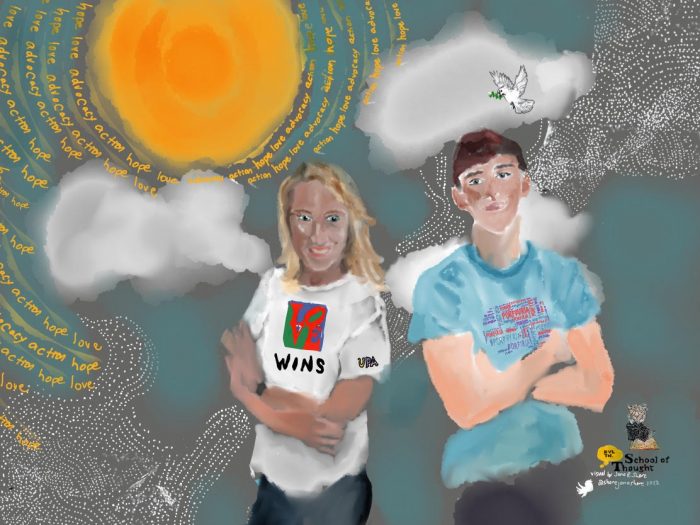Spring Can Be a Challenge for Those With EPP

With spring upon us, the birds are singing earlier in the morning. The flowers and trees will soon bud. Our clocks have already “sprung” forward. The air is warm, and the sun shines brighter and longer than it has in months.
But for some, the signs of spring don’t always prompt joy. For people like my son, Brady, 16, who lives with erythropoietic protoporphyria (EPP), the springtime’s much-anticipated brightness and warmth are a harbinger of pain and discomfort.
Of the nine major types of porphyria, the sun can trigger a painful reaction in all cutaneous porphyrias, which mainly affect the skin, and two of the four acute hepatic porphyrias, which mainly affect the nervous system.
While most people would understandably think that summer is the most difficult season for someone with EPP, I’ve heard time and again that spring is the hardest.
One patient described to me the transition from winter to spring as “EPP amnesia.” I’ve heard from other patients that during the dark months of winter, when days are shorter and everyone dresses alike, they almost forget about the extra weight of protective clothing that must be worn even on the most stifling days. But when the bright sun of spring appears, anxiety sets in as the itching and stinging begin, marking the onset of a reaction.
For those with EPP, spring means retreating back into the shadows, behind hats, gloves, tinted windows, and curtained rooms.
The sun’s harmful rays, which wreak havoc on their bodies, also can affect their minds. There is no joy in watching friends and family members shed their winter layers while those with EPP must plan every moment of their day and protect themselves with long sleeves, hats, and the tricks they’ve learned over the years to avoid unimaginable pain.
People have said the pain feels like putting your hand in boiling water then stabbing it with a knife or putting your head inside an oven. Easing this pain is practically impossible.

Brady and his mom in artwork by Jane R. Shore. (Artwork by Jane R. Shore, @shorejaneshore)
In her book “Wintering: The Power of Rest and Retreat in Difficult Times,” author Katherine May suggests that “wintering” is something we do to care for and repair ourselves. As I absorbed May’s wisdom, it occurred to me that EPPers ironically “winter” in the summer.
Brady and his peers need to be kindest to themselves — avoiding even the smallest amount of light — when the rest of the world is more relaxed and slowing down to soak up the sun. For them, isolation is frequent during daylight hours, while others gather at pools and in parks. Retreating isn’t a choice but rather a necessity.
As May writes, “It often seems easier to stay in winter, burrowed down into our hibernation nests, away from the glare of the sun.” Prophetic words for the life of an EPPer.
In 2015, when he was 10, Brady was featured in an episode of the TV show “Dateline NBC” titled “Out of the Shadows.” He was one of three children interviewed about the impact of living with phototoxicity.
NBC News correspondent Kate Snow sat down with Brady to interview him in our home. With cameras rolling, I heard Brady share that he “wanted to be just like them, my friends.” My heart ached and I wished with every ounce of my being that I could relieve him of the weight of this disease.
When the episode aired, Brady was hoping one day to be treated with Scenesse (afamelanotide), which was approved for adults in the U.S. three years ago. He has two more years to wait until his 18th birthday.

NBC’s Kate Snow chats with a younger Brady about EPP in March 2015. (Photo by Kristen Wheeden)
Two more investigational therapies are being studied: Mitsubishi Tanabe’s MT-7117, which is currently in a Phase 3 clinical trial, and bitopertin, which has a Phase 2 clinical trial planned for this year.
The future looks bright for people living with EPP. I relish the stories of those who can already access treatment, and I pray and work hard for those who are not yet treated.
Brady has shared with me that he just wants to feel safe. As a mom, caregiver, and advocate, I’ll forge ahead to offer that to him, others who live with EPP, and those living with all types of porphyria.
I tell Brady to be kind and gentle with himself while he “winters.” I tell him to hold on to hope that one day, he will be able to safely lift his face to the sun and it will bring him great warmth and joy.
Note: Porphyria News is strictly a news and information website about the disease. It does not provide medical advice, diagnosis, or treatment. This content is not intended to be a substitute for professional medical advice, diagnosis, or treatment. Always seek the advice of your physician or other qualified health provider with any questions you may have regarding a medical condition. Never disregard professional medical advice or delay in seeking it because of something you have read on this website. The opinions expressed in this column are not those of Porphyria News or its parent company, BioNews, and are intended to spark discussion about issues pertaining to porphyria.








Comments